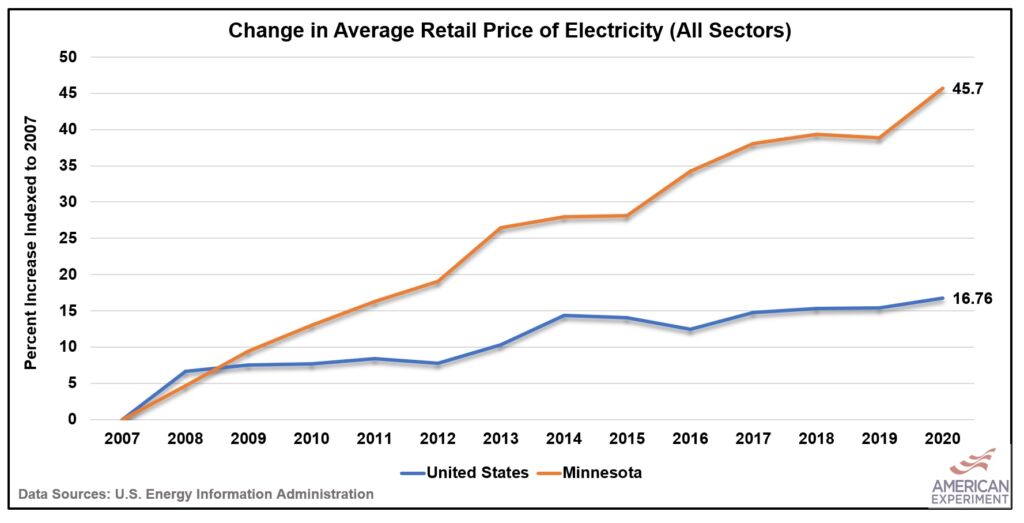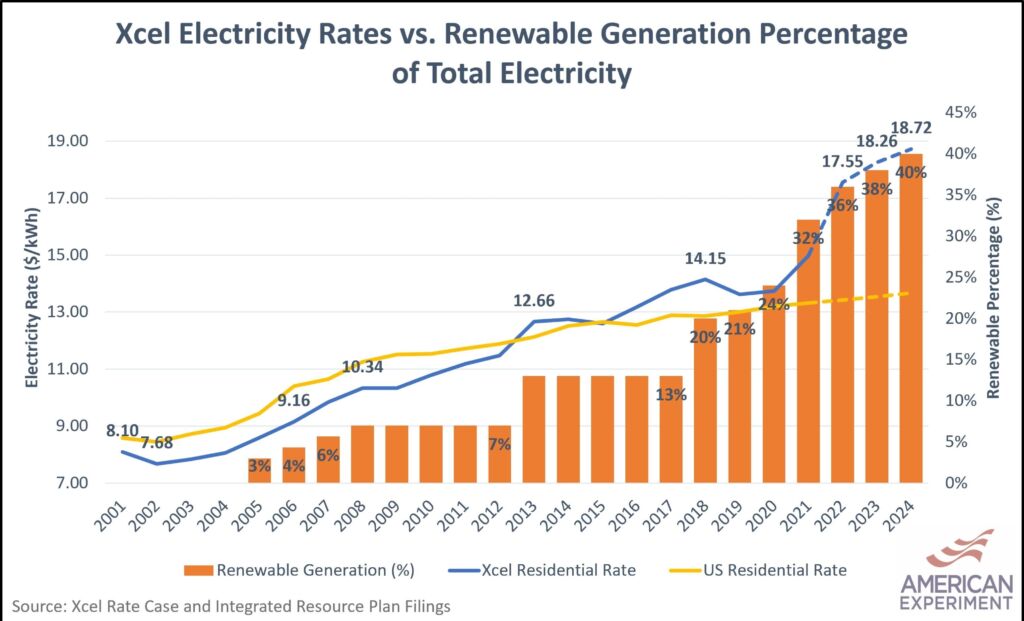Minnesota’s renewable energy mandate: 15 years of failure
Tuesday, Nov. 23 marks the 15th anniversary of the day then-Minnesota Governor Tim Pawlenty signed off on his renewable energy mandate, the Next Generation Energy Act (NGEA). Today is also the 15th anniversary of the day Minnesota’s electricity prices began to skyrocket, increasing 2.7 times faster than the national average since 2007.
Not only has the NGEA caused electricity prices to increase dramatically, it has also been used to justify other bad energy policies, like imposing Gov. Walz’s California car mandates and forcing businesses to quantify their greenhouse gas emissions as part of the permitting process.
Electricity prices escalated quickly
Minnesota’s electricity prices used to be nearly 20 percent below the national average, giving energy-intensive industries in the state, like agriculture, manufacturing, and mining, an enormous competitive advantage relative to firms operating in other states.
But that began to change when the NGEA was signed into law because it forced electric companies to start spending billions of dollars building wind turbines and solar panels to meet arbitrary government mandates. Electricity companies like Xcel Energy then raised the price of electricity to pay for the wind turbines and solar panels, and they even made a government-approved profit on top of it.
Since 2007, Minnesota’s electricity prices increased by 45.7 percent, whereas the United States as a whole only saw prices increase by 16.76 percent. That means Minnesota’s electricity prices increased 2.72 times faster than the national average.

The huge difference in prices will be even larger if the Minnesota Public Utilities Commission approves Xcel Energy’s proposal to increase the cost of electricity by 21.2 percent over the next three years. If these rate increases are approved, Xcel Energy’s electricity prices will be 40 percent higher than the national average by 2024.

Minnesota Power is also seeking to increase electricity prices by 18 percent, a devastating blow to the families in their service territory and the iron mines that use massive quantities of electricity. High electricity prices put thousands of high-paying mining jobs in jeopardy.
Higher costs, less reliability
Not only are electricity costs skyrocketing, but the reliability of the electric grid is eroding thanks to the NGEA and renewable energy mandates in other states.
Minnesota belongs to a regional electric grid called the Midcontinent Independent Systems Operator (MISO). MISO’s grid operators recently issued a report showing that the regional grid may not have enough reliable power plants to keep the lights on in a polar-vortex situation this January.
One reason we may not have enough reliable power plants online in a situation like this is that wind turbines don’t work very well during extremely cold temperatures. In fact, they are shut down when temperatures reach -22°F, and they become net users of electricity to heat the oil in their gearboxes.
Data from the Energy Information Administration show wind turbines produced less than 10 percent of their potential output during several hours during the Polar Vortex of 2021, when we needed the electricity the most.

Wind and solar mandates like the NGEA also reduce the number of reliable power plants on the grid by undermining wholesale power prices. Wholesale power prices are suppressed by federal subsidies and other market distortions that make it unprofitable to run reliable power plants. Texas wind and solar associations even bragged about how these energy sources were pushing reliable power plants off the grid before the blackouts.
Enabling bad ideas beyond electricity
The harmful impacts of the NGEA extend beyond rising electricity prices. In addition to requiring that 25 percent of Minnesota’s electricity come from wind or solar by 2025, the NGEA also contained non-binding goals to reduce greenhouse gas emissions by 15 percent below 2005 levels by 2015, 30 percent by 2025, and 80 percent by 2050.
These goals are being used as justification for implementing more bad policies that increase the cost of living for Minnesota families and heap more costs on to our businesses and job creators.
For example, when Gov. Walz announced he would be tasking bureaucrats at the Minnesota Pollution Control Agency to impose California car mandates on Minnesota, he pretended this policy was bi-partisan, citing the NGEA. In reality, Minnesota senate Republicans opposed these rules and tried to delay the implementation of the rules through the budget process.

Another example of these rules being used to regulate Minnesota’s economy is the Green New Permitting rules the Walz administration is seeking to enact through the Environmental Quality Board.
These new permitting regulations will be used by environmental law firms to oppose new projects in Minnesota on the grounds that they will emit carbon dioxide. This may already be happening, as wind and solar activists are signaling their opposition to a new wood processing facility in Cohassett because it will emit carbon dioxide.
These greenhouse gas emissions reduction goals are being used as a blank check to bureaucrats to implement policies without legislative oversight. More bad policies will no doubt stem from the NGEA in the future.
15 years of failure, the report
In 2022, Center of the American Experiment will be updating our 2017 paper, The High Cost of Failure, to do a full accounting of the costs of the NGEA since it was signed into law. The report will also show and what it will likely cost to keep building more wind and solar facilities in the state to meet the greenhouse gas emission reduction goals in the legislation.
The NGEA is one of the most economically destructive policies ever enacted in the state of Minnesota because it has turned energy prices into a liability when they were once an asset.
Rising energy prices drive up the cost of living because energy is the invisible ingredient in everything. By making energy more expensive, the NGEA damaged every sector of Minnesota’s economy. This makes it harder for Minnesota families to pay their energy bills, increasing every year.